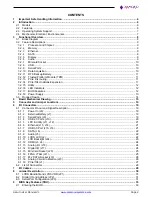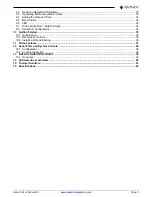
Saturn User Manual V1.01
Page 4
1 IMPORTANT SAFE HANDLING INFORMATION
WARNING!
ESD-Sensitive Electronic Equipment
Observe ESD-safe handling procedures when working with this product.
Always use this product in a properly grounded work area and wear appropriate
ESD-preventive clothing and/or accessories.
Always store this product in ESD-protective packaging when not in use.
Safe Handling Precautions
The Saturn SBC contains a high number of I/O connectors with connection to sensitive electronic components. This
creates many opportunities for accidental damage during handling, installation and connection to other equipment.
The list here describes common causes of failure found on boards returned to Diamond Systems for repair. This
information is provided as a source of advice to help you prevent damagi
ng your Diamond (or any vendor’s)
embedded computer boards.
ESD damage
– This type of damage is usually almost impossible to detect, because there is no visual sign of failure
or damage. The symptom is that the board eventually simply stops working, because some component becomes
defective. Usually the failure can be identified and the chip can be replaced.
To prevent ESD damage, always follow proper ESD-prevention practices when handling computer boards.
Damage during handling or storage
– On some boards we have noticed physical damage from mishandling. A
common observation is that a screwdriver slipped while installing the board, causing a gouge in the PCB surface
and cutting signal traces or damaging components.
Another common observation is damaged board corners, indicating the board was dropped. This may or may not
cause damage to the circuitry, depending on what is near the corner. Most of our boards are designed with at least
25 mils clearance between the board edge and any component pad, and ground / power planes are at least 20 mils
from the edge to avoid possible shorting from this type of damage. However these design rules are not sufficient to
prevent damage in all situations.
A third cause of failure is when a metal screwdriver tip slips, or a screw drops onto the board while it is powered on,
causing a short between a power pin and a signal pin on a component. This can cause overvoltage / power supply
problems described below. To avoid this type of failure, only perform assembly operations when the system is
powered off.
Sometimes boards are stored in racks with slots that grip the edge of the board. This is a common practice for board
manufacturers. However our boards are generally very dense, and if the board has components very close to the
board edge, they can be damaged or even knocked off the board when the board tilts back in the rack. Diamond
recommends that all our boards be stored only in individual ESD-safe packaging. If multiple boards are stored
together, they should be contained in bins with dividers between boards. Do not pile boards on top of each other or
cram too many boards into a small location. This can cause damage to connector pins or fragile components.
Power supply wired backwards
– Our power supplies and boards are not designed to withstand a reverse power
supply connection. This will destroy each IC that is connected to the power supply (i.e. almost all ICs). In this case
the board will most likely will be unrepairable and must be replaced. A chip destroyed by reverse power or by
excessive power will often have a visible hole on the top or show some deformation on the top surface due to
vaporization inside the package.
Check twice before applying power!
Board not installed properly in PC/104 stack
– A common error is to install a PC/104 board accidentally shifted
by 1 row or 1 column. If the board is installed incorrectly, it is possible for power and ground signals on the bus to
make contact with the wrong pins on the board, which can damage the board. For example, this can damage
components attached to the data bus, because it puts the
12V power supply lines directly on data bus lines.





































